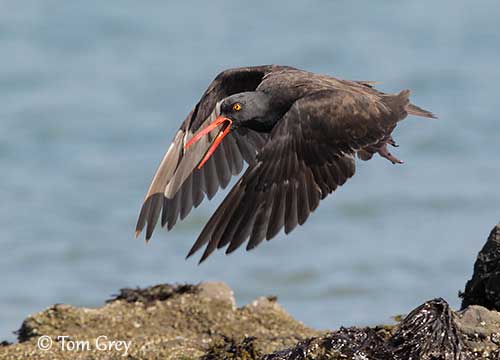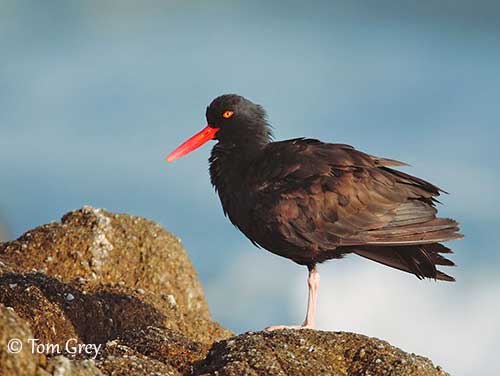
Black Oystercatcher
Haematopus bachmani
Charadriiformes Order – Haematopodidae Family
INTRODUCTION:
The Black Oystercatcher is sometimes lumped within the Blackish Oystercatcher according to the authors. On this page, this species is considered a monotypic full species. Both species are almost identical, but the present species is found only on the North American Pacific coasts, whereas the Blackish Oystercatcher occurs only on the South American coasts.
The Black Oystercatcher frequents rocky coasts and sea islets where it is difficult to see it against the dark rocks. It feeds on aquatic invertebrates of various species, depending on the season. It usually breeds on islands and the nest is on the ground.
The Black Oystercatcher is widely distributed and not globally threatened.
Its name pays tribute to the American naturalist John Bachman (1790-1874).

Fr: Huîtrier de Bachman
Ang: Black Oystercatcher
All: Klippenausternfischer
Esp: Ostrero Negro Norteamericano
Ita: Beccaccia di mare nera
Nd: Noord-Amerikaanse Zwarte Scholekster
Sd: klippstrandskata
Photographer:
Tom Grey
Tom Grey's Bird Pictures & Tom Grey's Bird Pictures 2
Text by Nicole Bouglouan
Sources:
HANDBOOK OF THE BIRDS OF THE WORLD Vol 3 by Josep del Hoyo-Andrew Elliott-Jordi Sargatal - Lynx Edicions - ISBN: 8487334202
SHOREBIRDS by Peter Hayman, John Marchant and Tony Prater – Christopher Helm – 1986 – ISBN: 0747014035
Birdlife International (under Blackish Oystercatcher)
What Bird-The ultimate Bird Guide (Mitchell Waite)
The Pacific WildLife Foundation
Bird Web (Seattle Audubon Society)
Wikipedia, the free encyclopaedia
The British Columbia Breeding Bird Atlas
DESCRIPTION OF THE BIRD:
Biometrics:
Length: 43-45 cm
Weight: M: 555-648 g – F: 618-750 g
The Black Oystercatcher is typically all-dark with brownish tinge on the upperparts, although head and neck are mostly black. The wings are fairly broad and rounded.
The long, straight bill is orange-red with yellowish tip. The eyes are yellow, surrounded by orange-red eyering. The strong legs and feet are pale pink.
The female is similar, but she is slightly larger and her bill is longer and thinner.
The adults in non-breeding plumage are very similar, but some individuals may have paler tips to belly feathers, and the legs may become slightly dusky.
The juvenile resembles adult, but the dark upperparts show buff-fringed feathers. The eyes are orange-brown, surrounded by a dull orange eyering. The bill is orange-brown and the legs are pinkish-grey.
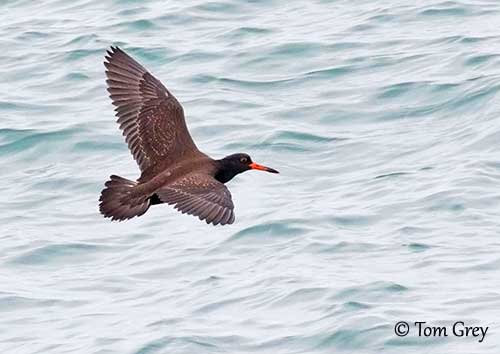
RANGE:
The Black Oystercatcher is found along the Pacific coast of North America, from W Aleutian Islands through S Alaska, W Canada and W USA to NW Mexico.
It is mostly found between S British Columbia and Baja California outside breeding season.
HABITAT:
The Black Oystercatcher frequents rocky shorelines all year round, and especially small offshore islands on which it breeds, usually close to abundant food resources.
Outside breeding season, it is mostly found on mudflats, close to the rocky coasts.
CALLS AND SONGS: SOUNDS BY XENO-CANTO
The Black Oystercatcher produces a rapid “peep-peep-peep” or only “pee-up”. When alarmed, it repeats a slow “peep”.
The rapid pipping accompanies the displays of both mates and increases in volume while becoming a long whistled series “prrrrrrrr-pre-preee-pee-peee-peee-purr-purr-pr”.
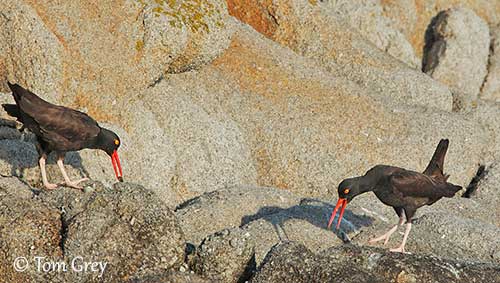
BEHAVIOUR IN THE WILD:
The Black Oystercatcher feeds primarily on mussels when available, but it also takes a variety of prey including limpets, whelks, urchins, crabs, marine worms and beetle larvae, depending on location and season.
It forages on the rocky reefs exposed at low tide. It may forage on sandy or shingle beaches too, and occasionally on mudflats.
The bird is able to open the shells of the mussels and other bivalves, by jabbing the bill into a slightly open shell, or by hammering on the shell to break it open.
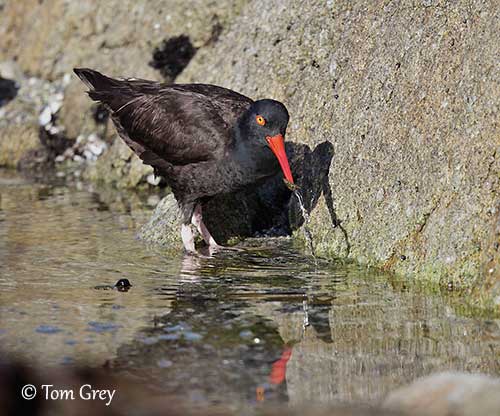
The Black Oystercatcher is often found alone or in small groups or mixed-species groups.
This species probably mates for life. The typical displays involve both partners running side-by-side with the head held forwards and the bill pointing downwards. These displays are accompanied by a rapid pipping sound.
The nest is built above the high-tide mark, among rocks or grasses, on cliffs or islands.
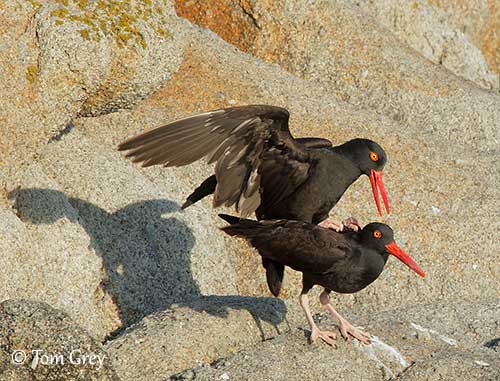
The Black Oystercatcher is sedentary. It may move seasonally in search of food, but it usually remains close to the nesting areas.
It has heavy, direct flight, due to the fairly broad, rounded wings. It flies low with powerful, stiff wingbeats.
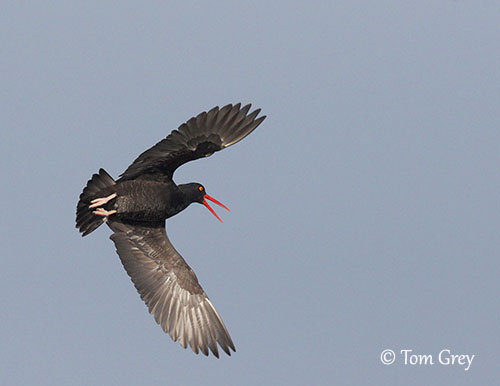
REPRODUCTION OF THIS SPECIES:
The laying occurs usually in May-June, and starts 15 days earlier in the southern part of the range.
The Black Oystercatcher builds a shallow scrape placed well above the high-tide mark. The nest is usually on gravel or grasses, or in rocky depression, and the birds add some pebbles or pieces of shell in the scrape. Both adults defend the nesting territory.
The female lays 1-4 pale buff/olive eggs with dark markings. Both adults share the incubation during 24-29 days. Soon after hatching, the dark downy chicks remain near the nest during the first days, guarded by one of the parents. The other adult forages for food and brings it back to the nest. Later, the young follow their parents to the feeding areas where they are still fed by the adults. They usually can fly at five weeks of age or later. They begin to feed themselves, but the adults feed them occasionally.
This species produces a single brood per season.
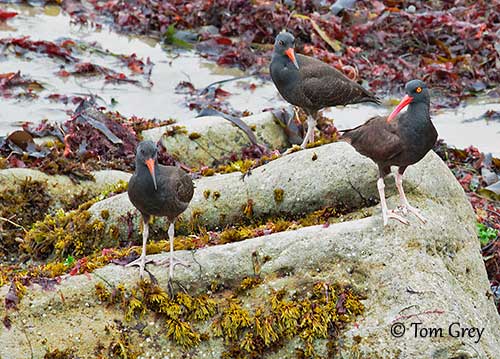
PROTECTION / THREATS / STATUS:
The Black Oystercatcher is not globally threatened. The species is still widespread along the North American Pacific coast, and they can be numerous in some areas.
The numbers decrease or increase, depending on the location, but their range is relatively free of humans and predators, as they nest on island and inaccessible cliffs.
However, the Black Oystercatcher is vulnerable to pollution, especially oil spills, in the intertidal areas where it forages. Disturbance at nesting sites may also affect the breeding success.
The population trend is stable and even increasing.
The Black Oystercatcher is currently evaluated as Least Concern.
